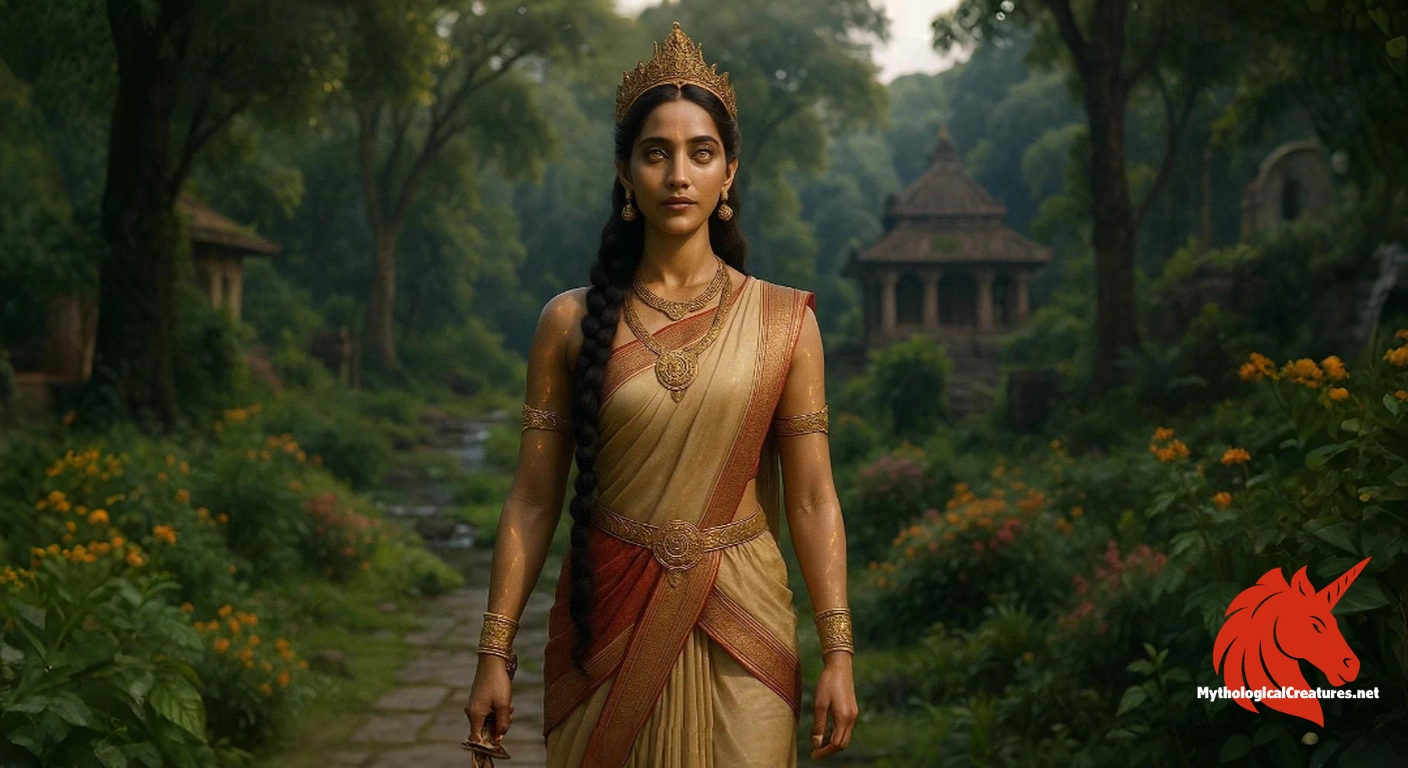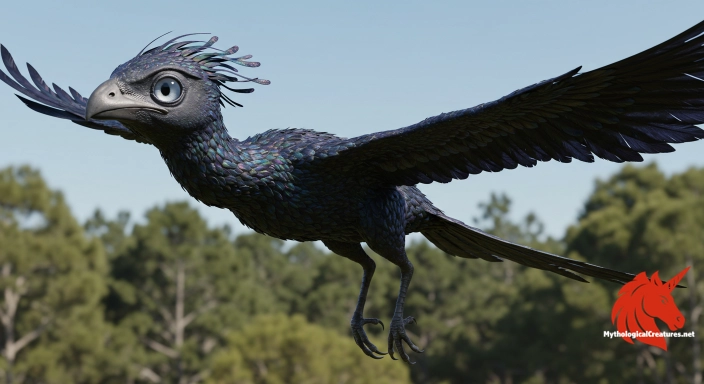Panthoibi: Panthoibi, also known as Nongpok Leima, is a revered goddess in Meitei mythology associated with love, wisdom, fertility, and warfare.

Panthoibi
Panthoibi - Her legacy inspires courage, independence, and social honour in Meitei culture, especially among women.
Origins & First Encounters
Panthoibi is a revered goddess whose mythic presence has illuminated the ancient cultural tapestry of Kangleipak, the early realm of Manipur. Her exalted persona, known as Nongpok Leima or the Queen of the East, intertwines divinity with the ideals of civilisation and courage. She emerges from a rich tapestry of tradition, symbolising fertility, love, and the creative spirit embedded in handicraft and warfare. Her origins are steeped in antiquity, with early attestations linking her to the divine continuity of Leimarel Sidabi. The depiction of Panthoibi resonates with the people’s aspiration for victory and wisdom, making her a central figure in the spiritual narrative of the region. Her consort, the God Nongpok Ningthou, further establishes her standing within a complex divine hierarchy. Early narrations celebrate her as a beacon of independence and social honour, particularly for Meitei women. The goddess’s myth not only encompasses the realms of battle and benevolence but also echoes the deep-rooted cultural values of ancient Manipur. Her enduring presence continues to inspire devotion and a sense of identity among those who celebrate her legacy.
Source Texts & Tale Variants
The legends of Panthoibi have been chronicled in a variety of traditional texts and oral recitations that have traversed generations. Ancient manuscripts from Kangleipak, enriched with lyrical narratives and dramatic episodes, provide a glimpse into her multifaceted role within local mythology. Her story is interwoven with intricate details that highlight her divine abilities and human-like passion, displaying variations that add depth to her character. Oral traditions have preserved her exploits through ritualistic recitations and stage performances, further solidifying her iconic status in folklore. The narrative presents her relationship with Nongpok Ningthou in various dimensions, emphasising both tender affection and martial prowess. Other story variants introduce subtle differences in her attributes, where aspects of love, courage, and artistic mastery are emphasised to reflect varying community needs. Some accounts depict her in the context of local fire rituals and agricultural festivities, underscoring her connection to fertility and renewal. Traditional recitations and dramatic poetry have not only served to entertain but also to instil societal values and cultural identity linked to her saga. The diversity of sources underscores a living mythology that continues to adapt and resonate across time.
Form & Powers
Traditional iconography portrays Panthoibi with an ethereal beauty that captivates and inspires awe. Her depictions often reveal a graceful figure adorned in richly embroidered garments that reflect the vibrant hues of the eastern landscapes. Intricate jewellery, passed down through generations, embellishes her visage and symbolises her elevated status among the divine. Artisans traditionally render her with luminous eyes that convey both wisdom and an unyielding passion for life. Her flowing hair and poised stance suggest a harmonious balance between delicate femininity and formidable strength. Visual narratives frequently illustrate her holding emblematic artefacts such as a sceptre or traditional musical instruments, representing her governance over fertility and art. Despite variations in size and style across artistic mediums, her overall presence remains both regal and approachable. The aesthetic elements central to her portrayal are imbued with symbolic references to nature, particularly the radiant energy of the eastern sun. Such depictions continue to be reinterpreted by modern artists who integrate traditional motifs with contemporary design elements.
Regional Faces
The myth of Panthoibi has traversed geographical boundaries, acquiring unique nuances in different regions of south and south-east Asia. In Manipur, her narrative is deeply embedded in the local cultural ethos where she is venerated as a symbol of both martial skill and nurturing benevolence. Regions such as Assam and Tripura have woven her story into their indigenous folk traditions, often blending her characteristics with local deities and natural symbols. In Bangladesh and Myanmar, devotional practices have adapted her iconography to align with cultural and historical influences, sometimes integrating elements from regional spiritual beliefs. This diffusion of her myth highlights an adaptive tradition where regional aesthetics and ceremonial practices influence her portrayal. Local adaptations have also brought forward distinctive rituals, festivals, and art forms that underscore her dual presence as a warrior and a nurturer. Variations in her depictions across these regions serve to underscore a shared spiritual heritage while also reflecting local cultural colours. The regional narratives continue to evolve, sustaining a dialogue between ancient lore and the modern interpretations of divine femininity. Such adaptations confirm her enduring significance as a unifying and culturally adaptive archetype.
Cultural Parallels
The martial and nurturing qualities of Panthoibi invite comparison with a number of revered deities in diverse mythological traditions. Her embodiment of wisdom and warfare mirrors aspects found in goddess figures such as Athena, who also epitomises strategic might blended with refined intellect. Similar to the fierce energy of Durga in Hindu mythology, Panthoibi reflects a balanced duality of strength and compassion, demonstrating resilience in the face of adversity. Her myth shares thematic resemblances with other cultural heroines who are celebrated for their ability to govern both the domestic and the combative spheres. The intermingling of love, creative artistry, and a warrior spirit in her narrative highlights a broader archetype seen in various global spiritual traditions. These parallels unexpectedly bridge the gap between the festive traditions of the Meitei people and the celebrated legends of other ancient cultures. The synthesis of these qualities within a single divine figure emphasizes a universal archetype that celebrates both the beauty and the power of femininity. Comparative reflections across cultures enrich the understanding of her myth by revealing common motifs of protection, creativity, and moral fortitude. Such cross-cultural dialogue underscores her position as a goddess whose attributes resonate far beyond her original regional context.
Legacy & Modern Evolution
The historical evolution of Panthoibi's myth has seen a dynamic reinterpretation from ancient times to the modern era. Her image, once primarily documented in classical texts and temple art, has been revitalised in contemporary literature, dance, and visual arts. In modern reinterpretations, she is increasingly revered as an icon of empowerment and resilience for women, reflecting ongoing societal dialogues about gender and cultural identity. Artistic representations have evolved from traditional carvings and manuscripts to modern media that celebrate her multifaceted nature. Progressive reinterpretations have embraced her dual roles as a nurturer and a warrior, symbolising a balance between compassion and strength in today’s world. Festivals and cultural events continue to honour her legacy, drawing on ancient rituals while infusing them with contemporary relevance. New narratives are also emerging that position her as a bridge between the storied past and the challenges of modern society. Her evolving legacy stands as a testament to a timeless myth that adapts to the changing tides of cultural expression. Panthoibi remains a potent emblem of how ancient divine narratives can inspire modern movements for social and artistic renewal.
Interesting Fact
An interesting aspect of Panthoibi is her dual role as both a nurturer of cultural values and a fierce warrior, exemplifying a rare blend of gentleness and strength.
Quick Creature Info
Features:
Our Mythic Legendary Rating:

Also Sometimes Known As:
Habitat:
Supernatural Powers:
Physical Attributes:
Abilities:
Behavior:
Lore:
Related Creatures, Tales or Lore
- EEmoinu
- PPhouoibi
References
Discover Another Mythical Legend You May Not Have Heard Of?
Uncover the mysteries of ancient folklore and expand your knowledge of legendary beings from cultures around the world.
Dare to Meet the Oozlum bird....
Mythical Disclaimer: The images and data on this site are derived from various historical and literary sources, but we have found that many myths often have multiple versions and interpretations across references, sometimes contradictory. As a result, these creature depictions are artistic interpretations—imaginative blends of folklore, legend, and a dash of AI guesswork. Because creature descriptions vary widely, our illustrations and accompanying information represent our best effort to honor mythology while bridging creative gaps. Enjoy these interpretations—just remember, we've done our best to respect the stories and validate available data, but in the realm of mythology, details often shift, imagination leads the way, and nothing is ever set in stone!
Curated by the Mythological Creatures Team (rev. May 2025)
